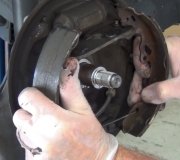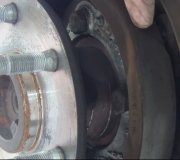The two most likely causes are a warped rotor from rough handling in shipping and debris stuck between the rotor and hub. The place to start is by running it in gear, jacked up and supported on jack stands, and watching the wheels from the front. Look for any sideways movement in the wheel at the outer edge where the weights clip on. One wheel will spin faster. To check the other one you have to block the one that's spinning. I use a 2" x 4" but be careful. If it's laying flat on the ground the tire can shoot it out.
If you don't see any sideways wobble in the wheels, remove them, reinstall three lug nuts, then watch the rotors as they spin. Mechanics will use a dial indicator to measure the lateral runout of each rotor, and a micrometer to measure for thickness variation. Thickness variation causes the brake pedal to pulse up and down. Lateral runout forces the caliper to slide back and forth on the mounts and that tugs on the steering linkage. It will be felt in the steering wheel. If you can feel the vibration in the steering wheel the runout is usually bad enough that you can see the caliper moving without using a dial indicator.
Warped rotors are also a common result of failure to use a click-type torque wrench on the lug nuts. The uneven clamping forces causes the rotors to warp from the uneven stress and heating and cooling cycles. The clue is the pulsation shows up weeks after the brake service was done. Warpage from rough handling or debris between the rotor and hub shows up right away.
Monday, March 1st, 2021 AT 10:21 AM


